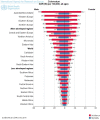Understanding variation in disease risk: the elusive concept of frailty
- PMID: 25501685
- PMCID: PMC4588855
- DOI: 10.1093/ije/dyu192
Understanding variation in disease risk: the elusive concept of frailty
Abstract
The concept of frailty plays a major role in the statistical field of survival analysis. Frailty variation refers to differences in risk between individuals which go beyond known or measured risk factors. In other words, frailty variation is unobserved heterogeneity. Although understanding frailty is of interest in its own right, the literature on survival analysis has demonstrated that existence of frailty variation can lead to surprising artefacts in statistical estimation that are important to examine. We present literature that demonstrates the presence and significance of frailty variation between individuals. We discuss the practical content of frailty variation, and show the link between frailty and biological concepts like (epi)genetics and heterogeneity in disease risk. There are numerous suggestions in the literature that a good deal of this variation may be due to randomness, in addition to genetic and/or environmental factors. Heterogeneity often manifests itself as clustering of cases in families more than would be expected by chance. We emphasize that apparently moderate familial relative risks can only be explained by strong underlying variation in disease risk between families and individuals. Finally, we highlight the potential impact of frailty variation in the interpretation of standard epidemiological measures such as hazard and incidence rates.
Keywords: Frailty; epigenetics; heterogeneity; random variation.
© The Author 2014. Published by Oxford University Press on behalf of the International Epidemiological Association.
Figures









Comment in
-
Commentary: Frailty and cancer.Int J Epidemiol. 2015 Aug;44(4):1423-4. doi: 10.1093/ije/dyv046. Epub 2015 Apr 4. Int J Epidemiol. 2015. PMID: 25842266 No abstract available.
-
Commentary: Age and frailty-not quite the same thing.Int J Epidemiol. 2015 Aug;44(4):1421-3. doi: 10.1093/ije/dyv045. Epub 2015 Apr 7. Int J Epidemiol. 2015. PMID: 25855711 No abstract available.
-
Commentary: Frailty and heterogeneity in epidemiological studies.Int J Epidemiol. 2015 Aug;44(4):1425-6. doi: 10.1093/ije/dyv044. Epub 2015 Apr 15. Int J Epidemiol. 2015. PMID: 25878216 No abstract available.
References
-
- Hougaard P. Analysis of Multivariate Survival Data. New York: Springer, 2000.
-
- Aalen OO, Borgan Ø, Gjessing HK. Survival and Event History Analysis: A Process Point of View. New York: Springer, 2008.
-
- Wienke A. Frailty Models in Survival Analysis. Boca Raton, FL: Chapman & Hall/CRC, 2011.
-
- Svensson E, Rogvin M, Hultman CM, Reichborn-Kjennerud T, Sandin S, Moger TA. Schizophrenia susceptibility and age of diagnosis – A frailty approach. Schizophr Res 2013;147:140–46. - PubMed
-
- Aalen OO, Tretli S. Analyzing incidence of testis cancer by means of a frailty model. Cancer Causes Control 1999;10:285–92. - PubMed
Publication types
MeSH terms
LinkOut - more resources
Full Text Sources
Other Literature Sources

